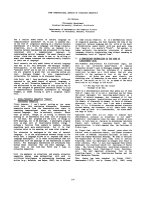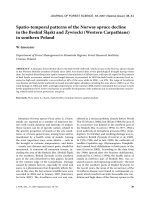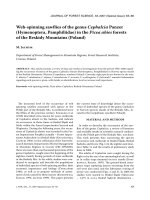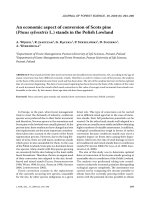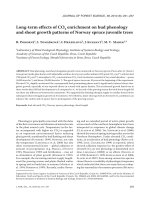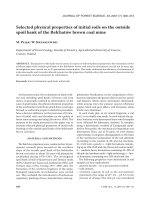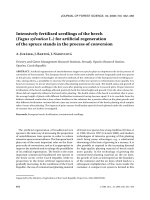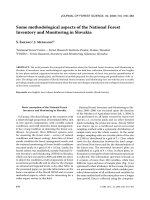Báo cáo lâm nghiệp: "Some methodological aspects of the National Forest Inventory and Monitoring in Slovakia" pptx
Bạn đang xem bản rút gọn của tài liệu. Xem và tải ngay bản đầy đủ của tài liệu tại đây (418.69 KB, 8 trang )
476 J. FOR. SCI., 54, 2008 (10): 476–483
JOURNAL OF FOREST SCIENCE, 54, 2008 (10): 476–483
Basic conception of the National Forest
Inventory and Monitoring in Slovakia
In Europe, Slovakia belongs to the countries with
a relatively high proportion of forestland (40%), rich
in tree species composition, with variable natural
conditions, and with intensive forest management.
It has a long tradition in detecting the forest con-
ditions. At present, three different systems exist
for assessing the forest state – survey of natural
conditions and forest ecology, detection of forest
stands condition for forest management needs, and
the national monitoring of forest health conditions
executed yearly in a grid of 16 × 16 km. Lately, the
fourth system was established, namely National Fo-
rest Inventory and Monitoring (NFIM) in Slovakia,
which was first executed in 2005 and 2006. Its aim is
to detect the conditions of all components of forest
ecosystems periodically and to observe the changes
on national and regional levels, as by other NFIs. In
the presented paper, we provide information on the
basic conception of the Slovak NFIM and on some
methodical aspects, which can be interesting for a
wider expert society in this field.
National Forest Inventory and Monitoring in Slo-
vakia 2005–2006 was executed upon the decision
of the Ministry of Agriculture from July 1, 2004. It
was performed on all lands covered by forest tree
species, i.e. on forest lands and on other forested
lands including the protected areas. Slovak NFIM
was drawn up as a combined aerial-terrestrial
sampling method with a systematic distribution of
sample units over the whole country. In the aerial
images, sampling units are circular plots of the size
of 2,500 m
2
distributed in a grid of 2 × 2 km, which
serve for the distinction between the land catego-
ries Forest/Non-forest and for the determination of
the forest area. e terrestrial inventory plots are
established in a grid of 4 × 4 km. In these plots, in-
formation covering the whole information spectrum
is collected. e information spectrum is broad, as
it consists of more than 100 variables, while four
different types and sizes of sample plots (Fig. 1) are
optimised to their attributes. In the terrain, the plots
are permanently invisibly fixed, which enables peri-
odical observations of all attributes and variables by
the same method and at the same place over a longer
time period. Data is collected using the computer-
Some methodological aspects of the National Forest
Inventory and Monitoring in Slovakia
Š. Š
1
, J. M
2
1
National Forest Centre – Forest Research Institute Zvolen, Zvolen, Slovakia
2
FORIM – Forest Research, Inventory and Monitoring, Sobrance, Slovakia
ABSTRACT: e work presents the conceptual information about the National Forest Inventory and Monitoring in
Slovakia. It introduces some methodological approaches to the field data collection (determination of tree heights
by two-phase method, regression formulas for tree volumes and assortments of forest tree species, quantification of
deadwood volume in sample plots) and biometrical models prepared for data processing and generalisation of the re-
sults. e design and conception of Slovak National Forest Inventory and Monitoring were set with the aim to enable
providing complex and integrated information about the state and changes of production and ecological characteristics
of the forest ecosystems.
Keywords: tree heights; tree volume; deadwood volume; biometrical models; Slovak forestry
J. FOR. SCI., 54, 2008 (10): 476–483 477
based Field-Map Technology (IFER 1999–2006).
e whole implementation of NFIM is ensured by
the National Forest Centre in Zvolen in accordance
with detailed methodological instructions (Š
et al. 2005, 2006).
Slovak NFIM in its form fulfils the latest scientific
and practical requirements for the complex detec-
tion and periodical comparison of the forest condi-
tion. Its precision level is restricted to a large extent
by the lack of financial resources, and thus the grid of
the sample plots (4 × 4 km) is relatively sparse. is
will ensure sufficient precision of the final data only
on the national level (by forest area 1%, by timber
volume 1.5%), while on the regional level the preci-
sion will be 2–4 times lower. e next Slovak NFIM
is presumed to be carried out in years 2014–2016 in a
denser grid (terrestrial 2 × 2 km, and in low forested
areas 1.41 × 1.41 km, and an aerial grid of 1 × 1 km,
or 500 × 500 m) to obtain more exact data.
Determination of tree heights by two-phase
method – a combination of estimation
and measurement
e determination of tree heights in the sample
plots belongs to serious methodological problems.
On one hand, “one tree principle” is in general
pushed forward, i.e. the requirement to know the
heights of all trees in a sample plot, which enables
to record the forest height structure in its whole
variation range and is also optimal for the derivation
of other variables (tree volume and its increment,
assortments etc.). On the other hand, from the eco-
nomical point of view, one is forced to consider the
measurement of tree heights on a smaller number of
trees (sample trees), and to assign to the rest of the
trees the average height value from the local height
curve derived from the sample plot or from the
general height tariff. is method has several disad-
vantages – it reduces the real variability of heights
and can cause deviations in the height of individual
trees by several metres.
Based on our previous research (Š 1994), a
two-phase method, i.e. the combination of estima-
tion (E) and measurement (M), was chosen for the
Slovak NFIM. First, the heights of all n
1
trees in the
sample plot are estimated (qualified ocular estima-
tion is ensured by previous training). Next, a sub-
sample of n
2
trees is determined, and the heights of
these trees are measured. For example, each second
or third tree is selected preferably from higher trees
(according to the principle of unequal probabilities).
It is specified that a minimum of 10 trees have to be
measured. If there are less than 20 trees in the sample
plot, all trees are measured. During the subsequent
data processing, the estimated heights h
E
are recti-
fied using the PPP-sampling theory with a multiple
quotient q
–
as follows:
Fig. 1. Scheme of the sample plot (on the left-hand side without subplots, on the right-hand side divided into 2 subplots):
A – a constant circle with radius r = 12.62 m, on which terrain, site, stand and ecological characteristics, food sources
for animals are detected and lying deadwood and stumps are inventoried, B – two concentric circles (r = 12.62 m and
3 m) for detecting tree characteristics on trees with diameter at breast height d
1.3
≥ 12 cm (B
1
) and d
1.3
= 7–12 cm (B
2
),
C – a variable circle for thin trees with diameter d
1.3
< 7 cm, its radius r = 1.0 m, 1.41 m or 2.0 m is chosen according to
tree density, D – an enlarged constant circle with radius of 25 m established for the inventory of forest edges, forest roads
and water sources
478 J. FOR. SCI., 54, 2008 (10): 476–483
n
2
Σ
q
i
i=1
h
i(korig)
= h
i(E)
× q
–
q
–
= –––––– ,
n
2
h
i(M)
q
i
= –––––– , i = 1, 2 n
2
(1)
h
i(E)
e necessity for rectification is examined by a
statistical test. In the case that the quotient q
–
does
not differ from 1.00 significantly, the rectification is
not needed, and the height estimated is considered
to be equal to that measured (i.e. deviations are not
systematic, but have a random character and are in
tolerance with natural measurement variability).
e presented method meets both above-men-
tioned requirements – it provides tree heights in the
whole variation range, while its work and time de-
mands are acceptable and the results are sufficiently
precise. e experience obtained from the database
showed that only in 21% cases the height estimations
deviated from the measurements systematically (i.e.
they were biased), in general they very closely cor-
related with the measurements, the variability of q
i
(s
q
%) being only 9.8%.
Set of regression formulas for tree volumes
and assortments of forest tree species
Timber volume determination and its assortment
structure is a key task of every NFI, while several
specific conditions must be met. For automated
data processing, appropriate mensurational rela-
tions expressed in a mathematical form are re-
quired. e results obtained are to be stated in the
volume units used in national conditions, and at
the same time comparable on a wider international
scale. The results should also provide effective
background information for more comprehensive
utilisation.
Considering these demands, the following solution
was taken for the NFIM of the SR. e suitability of
the existing volume and assortment tables and of
their mathematical models was verified with regard
to the purpose of the NFIM. It was shown that the
volume regression formulas v = f(d
1.3
, h) for 12 for-
est tree species (P, P 1991) satisfactorily
describe the tree volumes (v) over the whole range of
diameters (d
1.3
) 0.1–100 cm and heights (h) 1.3–45 m
(see Fig. 2). Only small corrections or substitute so-
lutions were necessary. In the case of less frequent
tree species, the volume formulas for related tree
species (in accordance with morphological stem
similarity) were used. It was decided, that the tree
volumes would be determined in three volume units
as follows:
(1) commercial timber (i.e. wood with minimum
diameter at the top end 7 cm) inside bark, which
is usually used in home practice,
(2) commercial timber outside bark used in most
European NFIs,
(3) total tree volume outside bark, which will be used
for determining the carbon content in woody
biomass and in its basic components (tree, stem,
branches, bark).
Fig. 2. Course of the volume formula v = f(d
1.3
, h) for spruce and its stem volume outside bark
Volume (m
3
)
Volume (m
3
)
14
13
12
11
10
9
8
7
6
5
4
3
2
1
0
0.15
0.10
0.05
0.00
0 10 20 30 40 50 60 70 80 90 100
dbh (cm)
0 1 2 3 4 5 6 7 8
dbh (cm)
5
10
15
20
25
30
35
40
Height (m)
J. FOR. SCI., 54, 2008 (10): 476–483 479
e differences in those three volume units are
actually rather high – e.g. standing volume per 1 hec
-
tare for all tree species from the NIML database re-
sulted in 266–298–334 m
3
, i.e. their relative indeces,
being 1.00–1.12–1.25, respectively. Mathematical
models for the partition of tree volume into 6 differ-
ent assortment types (P, N 1991) were
also shown as usable. ey are derived for all main
tree species, the input data being the tree diameter
and height, quality of the bottom third of the stem
(A, B, C), stem damage (yes, no), and in the case of
the beech also the age and growth area (flysch). In the
outputs of the Slovak NFIM, aggregated assortment
types will be used, and for monitoring the changes
in the quality structure of the forest stands relative
proportions of trees in individual quality classes
will be determined. Information about tree volumes
from the models of volume and assortment tables
is interconnected. By now, the use of another diam-
eter d
k
from a higher part of the stem in the model
v = f(d
1.3
, h) has not been considered. Although also
in Slovak conditions Ď and Š (2002)
found that adding another diameter d
7m
or d
0.3h
im-
proves the description of an actual stem shape of the
tree and increases the precision of the tree volume
determination (standard error will decrease by 0.62),
the necessary three-argument volume modules
v= f(d
1.3
, h, d
k
) are not available at the moment.
Quantification of deadwood volume
in sample plots
Lately, standing and lying deadwood in forest
ecosystems has become more and more significant
and hence, its detection was included within almost
all NFIs in Europe. The assessment methods for
obtaining necessary information vary between the
countries; they differ in the definitions of individual
parts of this wood, in the lower limit from which it
is recorded, and in detection details. While in the
case of small-sized wood only the estimation of its
coverage in the sample plot is usually carried out, for
larger deadwood its volume is also determined.
In the Slovak NFIM, the chosen methodology al-
lows to quantify the volume of all deadwood, both
large and small-sized. Standing dead trees are in-
ventoried by the same method as living trees. In the
case of the lying large deadwood (with minimum top
diameter outside bark 7 cm), its length and diameter
at both ends of the piece situated within the sample
plot are measured, and its volume is calculated by
Smalian’s method. e stumps from felled or dead
trees are recorded if their diameter is 7 cm or more
(at the standard height of 0.2 m above ground), their
height and diameter on the cut section are measured,
their volume is determined by stereometry, while
the shape of the bottom stem part is considered in
a simpler form (using the models of morphological
curves for all main tree species).
For the lying small-sized wood, two-phase detec-
tion was tested:
(1) e first phase is carried out on each sample
plot, or a subplot. e following characteristics
are estimated: relative coverage of small-sized
lying deadwood, prevailing group of tree spe-
cies (coniferous, broadleaved), its average di-
ameter (with precision of 1 cm), and average
decomposition grade. Relative coverage stands
for the percentual proportion of the total area
of the sample plot, which would be covered by
small-sized lying deadwood if all pieces were
placed side by side. In the case that deadwood
is huddled together, or placed into a pile, it is
estimated what area this wood would cover after
its dismantling.
(2) e second phase of detection is carried out only
on each fourth sample plot (with a random start,
e.g. on sample plots No. 2, 6, 10, etc.). Its aim is
to determine the volume of small-sized wood
in m
3
, which corresponds to the area, or to the
relative coverage of small-sized wood estimated
during the first detection phase. is is achieved
on the basis of sample piles taken as follows:
– From the occurring small-sized wood with the
diameter of 1–7 cm, a sample pile with dimen-
sions W (width) and L (length) is created in the
selected sample plot. Individual pieces of small-
sized wood are placed side by side as densely
as possible, while the width W of the sample
pile should be approximately 1 m and its length
L should correspond to the average length of
pieces with the diameter of up to 1 cm at the
top end. e pieces can be placed once from the
bottom end and once from the top end.
– For each sample pile, which is delimited by the
range poles, the following characteristics are as-
sessed. Its width W and length L are measured
with precision of 0.05 m, the prevailing tree
species and prevailing decomposition grade are
estimated, and the diameters of all small-sized
wood pieces are measured in the half of their
average length L/2 with a simple measuring tool
(Fig. 3).
– Using the data obtained, a biometric model is
derived, which expresses the real wood volume
of densely placed small-sized wood in an area of
1 m
2
as a function of the tree species and aver-
age small-sized wood diameter, and if necessary,
480 J. FOR. SCI., 54, 2008 (10): 476–483
also of other attributes influencing the given
relation. Using this model, the volume of small-
sized lying deadwood will be estimated also on
other NFIM sample plots. Fig. 4 presents such a
model derived from the 2005 and 2006 database.
As can be seen, the relation between the volume
and average diameter is tight and hence, well ap-
plicable.
Apart from the described second phase, another
alternative was also tested, namely the line intersect
sampling (S, B 1996). In each fourth
sample plot, two perpendicular lines were estab-
lished, one in the direction North-South, the other
in the direction West-East. With all pieces of small-
sized lying deadwood, diameter d
i
was measured at
the point of intersection with the line with a simple
measuring tool, with precision of 1 cm. e volume
of small-sized deadwood T in m
3
per 1 hectare was
directly derived from the measured diameters m of
small-sized wood pieces using the formula
π
2
m
T = –––––
Σ
d
i
2
i = 1, 2 m (2)
8L
i=1
(valid regardless of wood pieces length). is variant
showed to be less suitable for the volume estimation
than the first one, probably because of the insuffi-
cient length L of lines set for this purpose (quadruple
the radius of the sample plot = 50.48 m).
Biometrical models used to generalise
the results from sample plots for
the whole inventoried territory
e data obtained from the sample plots have to
be numerically processed and generalised for the
whole inventoried territory using specific math-
ematical-statistical (biometrical) models, which
cannot be universal but have to correspond to the
used sampling design of the NFI and the properties
of detected variables. First, it is necessary to con-
sider if the sample plots are equal or variable in size,
if they are distributed at random or systematically
over the inventoried territory, and if the variables are
quantitative or qualitative (categorical). e aim is to
derive parameters applicable to the entire country or
its parts on the basis of a relatively small sample size
(from n sample plots), and to determine the precision
frames of their determination.
In this contribution, we discuss only two of such
parameters – total and mean values of the stand
quantitative variable, and the relative proportion of
the tree qualitative variable. e models are derived
Fig. 3. Simple measuring tool used for measuring diameter of
small-sized wood
Fig. 4. Volume of small-sized lying deadwood
(m
3
) placed at 1 m
2
as a function of its aver-
age diameter
y = 0.0033x
1.5151
R
2
= 0.77
Volume of lying small-sized wood (m
3
/m
2
)
0.030
0.025
0.020
0.015
0.010
0.005
0.000
0 1.5 2.0 2.5 3.0 3.5 4.0 4.5
Average diameter (cm)
J. FOR. SCI., 54, 2008 (10): 476–483 481
with regard to the fact that the Slovak NFIM has a
systematic sampling design and that the stand and
tree variables of trees with diameter d
1.3
equal to or
above 12 cm were determined in the sample plot B
1
,
which is of a constant size of 500 m
2
. However, in
the cases where the sample plots were situated on
the boundary Forest/Non-forest or encompassed
different forest categories (different age, ownership
category etc.), the sample plots were divided into
smaller parts – subplots, resulting in a variable area
of the sample units.
Estimation of parameters of the stand
quantitative variable
Let us assume that we evaluate the stand quantita-
tive variable Y, e.g. timber stock, the number of trees
etc. e target parameter, which has to be determined,
is τ
Y
– actual total value of variable Y in the whole for-
est area A. is is equal to the sum of values y
i
of all
i = 1, 2 N individuals (trees) in the population
N
τ
Y
=
∑
y
i
(3)
i=1
or to the forest area A multiplied by average µ
Y
re-
lated to l ha
τ
Y
= Aµ
Y
(4)
In the Slovak NFIM, model (4) is used. Area A is
determined from the sample results of aerial and
terrestrial inventory. Average µ
Y
is estimated by
sample mean Y
–
obtained by measuring the variable
Y on m
i
trees situated in n sample plots, each of an
area X
i
. Standard error of estimation τ
Y
from the
sample results is:
S
Y
=
√
A
2
S
Y
2
+ Y
–
2
S
A
2
(5)
e estimation of µ
Y
by Y
–
can be executed by either
of the two methods described below.
A) e method “Ratio of Means”. is model is
generally valid for random sampling (L,
H 1973; C 1977; S et
al. 1990, etc.). It is based on the averages, or on
the sums of values of the quantitative variable
Y
i
and the area of the sample plot X
i
, where the
average µ
Y
is estimated from the proportion
R
–
with standard error S
R
–
n
∑
Y
i
Y
–
i =1
R
–
= –––– = ––––– (6)
X
–
n
∑
X
i
i=1
n n n n
∑
(Y
i
–RX
i
)
2
∑
(Y
i
2
+
R
2
∑
X
i
2
– 2R
∑
X
i
Y
i
i=1
i=1
i=1 i=1
S
R
–
=
√
–––––––––– =
√
––––––––––––––––––––– (7)
n(n–1)X
2
n(n–1)X
2
e magnitude of standard error (7) is influenced
by the variability of Y
i
and X
i
values, as well as by
their correlation (r
YX
). Similarly, the relative standard
error is derived from the relative standard errors of
these components according to the relation
S
R
% = √ (S
Y
–
%)
2
+ (S
X
–
%)
2
– 2r
YX
S
Y
–
%S
X
–
% (8)
B) The method “Mean of Ratios”. This mod
-
el was recommended by S and
Š (1998), and Š and S
(1999) for systematic sampling of unequally
sized sample plots. On the basis of the theoreti-
cal analysis and computer simulations, the au-
thors found that in the case of systematic design,
the probability to be selected into the sample is
higher for larger sample plots than for smaller
plots, what causes a systematic deviation (bias)
in the estimations. erefore, in each sample
plot (i) the sample data Y
i
need to be recalcu-
lated to equal area (1 ha) using the following
formula:
Y
i
Y
ha
(i) = –––– (9)
X
i
ese hectare values Y
ha
(i) are used for the estima-
tion of µ
Y
and S
Y
–
as follows:
n
∑
Y
ha(i)
i=1
Y
–
ha
= ––––––– (10)
n
n
∑
(Y
ha(i)
– Y
–
ha
)
2
i=1
S
Y
–
ha
=
√
–––––––––––––– =
n(n–1)
n
(∑
Y
ha(i)
)
2
n
i=1
∑
(Y
ha(i)
2
– –––––––––
i=1
n
=
√
–––––––––––––––––––––– (11)
n(n – 1)
A preliminary assessment of the data from the Slo-
vak NFIM by both methods provided e.g. for com-
mercial timber (i.e. wood with minimum diameter
at the top end 7 cm) inside bark with all tree species
these results:
482 J. FOR. SCI., 54, 2008 (10): 476–483
R = 266.2 m
3
, S
R
= ± 5.15 m
3
and Y
ha
= 263.9 m
3
,
S
Y
–
ha
= ± 5.16 m
3
.
The differences in the average value 2.3 m
3
(0.9%)
and in standard error 0.01 m
3
(0.2%) are not very
high. Further spatial analyses, e.g. geostatistics and
correlation analyses, did not reveal any significant
systematic trends in the distribution of the values
of basic variables over the whole country. For ex-
ample, the correlation coefficients calculated for
basal area per hectare within the distance of 50 km
fluctuate between –0.12 and 0.34. This shows that
the spatial autocorrelation between the values is
low and practically negligible. Due to these facts,
the first model A, was applied in the evaluation of
NFIM data.
Estimation of parameters
of tree qualitative variable
Let us assume that we evaluate a tree qualitative
variable, for example the relative proportion of
trees π in quality classes A, B, C. We estimate the
proportion π
A
by, the sample proportion p
A
and its
standard error S
PA
based on the number of trees
a
i
belonging to class A and on the total number of
trees m
i
on individual sample plots i = 1, 2 n. is
is a typical cluster sampling with unequal numbers
of individuals because the number of trees m
i
will
always vary, even if the area of the sample plots is
constant. us, the proportion p
A
and its standard
error S
pA
has to be determined using the model
“Ratio of Means”:
n
∑
a
i
i=1
p
A
= –––––––– (12)
n
∑
m
i
i=1
n n n
∑
a
i
2
+ p
A
2
∑
m
i
2
– 2p
A
∑
a
i
m
i
i=1 i=1 i=1
S
pA
=
√
–––––––––––––––––––––––––––– (13)
n(n – 1)m
–
2
It can be proved, that in this case the estimate de-
rived from binomial distribution cannot be used
n
∑
a
i
i=1
p
A
= –––––––– (14)
n
∑
m
i
i=1
p
A
(1 – p
A
)
S
pA
=
√
––––––––– (15)
n
∑
m
i
– 1
i=1
as this is applicable only to one-tree sampling
(sampling of individual trees over the whole area).
Although this method gives a good estimate of p
A
,
the calculated standard error is incorrect, having a
much lower value. Likewise, the approach based on
the proportions p
A(i)
assigned to each sample plot
individually is not applicable
n
∑
p
A(
i
)
a
A(i)
i=1
p
A(i)
= ––––– p
A
= –––––
m
i
n
n
∑
(
p
A(i)
– p
A
)
2
i=1
S
pA
=
√
–––––––––––– (16)
n(n – 1)
is method could be used only if the total number
of trees m
i
in the sample plots were the same in all
sample plots. e discrepancy in the results obtained
from these three methods is documented in the fol-
lowing example. e results document the propor-
tion of spruce trees in quality class A calculated from
the Slovak NFIM database:
Ratio
of means
Binomial
distribution
Method ad
(16)
p
A
= 0.1235 0.1235 0.1411
S
pA
= ± 0.0162 ± 0.0056 ± 0.0158
e presented considerations demonstrate that
the data processing of the Slovak NFIM 2005–2006
varies with regard to the model characteristics and
features of the evaluated variable.
CONCLUSION
e presented article gives information on the
basic characteristics of the Slovak NFIM, which was
first executed in years 2005–2006 as a pilot project
and its implementation at the same time. We also
present some methodological approaches to the field
data collection and biometrical models prepared for
data processing and generalisation of the results.
e NFIM methodology makes use of the existing
international experience and knowledge from our
own research at a maximum rate. It is characterised
J. FOR. SCI., 54, 2008 (10): 476–483 483
by a high variation in the selection of the design of
sample plots, in the assessment of variables, and in
their biometric evaluation. e aim was to optimise
the methods in such a way that they may best suit the
features of the detected variables, applied sampling
design, and economical requirements.
Refer enc es
COCHRAN G.V.,
1977. Sampling Techniques. New York,
John Wiley & Sons, Inc.: 428.
ĎURSKÝ J., ŠMELKO Š.,
2002. Individuálny tvar kmeňa
stromov a možnosti jeho zohľadnenia v stromových
simulátoroch rastu. Acta Facultatis Forestalis, XLIV:
131–141.
LOETSCH F., HALLER K.E., 1973
. Forest Inventory. Volume
1. Munchen, Bern, Wien, BLV: 436.
PETRÁŠ R., PAJTÍK J., 1991
. Sústava česko-slovenských ob-
jemových tabuliek drevín. Lesnícky časopis, 37: 49–56.
PETRÁŠ R., NOCIAR V.,
1991. Sortimentačné tabuľky
hlavných drevín. Bratislava, Veda: 304.
SABOROVSKI J., ŠMELKO Š.,
1998. Zur Auswertung von
Stichprobeninventuren mit variablen Probeflächengrößen.
Allgemeine Forst- und Jagdzeitung, 169: 71–75.
SCHEAFFER R.L., MENDENHALL W., OTT L., 1990
. El-
ementary Survey Sampling. Boston, PWS-KENT Publishing
Company: 403.
SHIVER B.D., BORDERS B.E., 1996
. Sampling Techniques
for Forest Resources Inventory. New York, John Wiley &
Sons, Inc.: 336.
ŠMELKO Š., 1994
. e two-phase method of determination
of tree heights on permanent monitoring plots. In: BUBLI
NEC E.
(ed.), Ecological stability, diversity and producti-
vity of forest ecosystems. Zvolen, Institute of Forest
Ecology SAS: 403–408.
ŠMELKO Š., SABOROWSKI J., 1999
. Evaluation of variable
size sampling plots for monitoring of forest condition.
Journal of Forest Science, 45: 341–347.
ŠMELKO Š., MERGANIČ J., ŠEBEŇ V., RAŠI R., JANKOVIČ
J., 2005. Národná inventarizácia a monitoring lesov Slo-
venskej republiky 2005–2006. Metodika terénneho zberu
údajov – 3. verzia. Zvolen, NLC – LVÚ Zvolen: 107.
ŠMELKO Š., MERGANIČ J., ŠEBEŇ V., RAŠI R., JANKOVIČ
J., 2006. Národná inventarizácia a monitoring lesov Slo-
venskej republiky 2005–2006. Metodika terénneho zberu
údajov – 3. doplnená verzia. Zvolen, NLC – LVÚ Zvolen:
130.
IFER 1999–2006. Field-Map Technology.
Received for publication March 28, 2008
Accepted after corrections July 17, 2008
Niektoré metodické aspekty národnej inventarizácie a monitoringu lesov
na Slovensku
ABSTRAKT: Príspevok prezentuje základnú koncepciu Národnej inventarizácie a monitoringu lesov (NIML)
Slovenska, ktorá sa po prvýkrát uskutočnila v rokoch 2005–2006. Opisuje niektoré metodické princípy terénneho
zberu údajov (určovanie výšok stromov dvojfázovou metódou, regresné rovnice uplatnené pri stanovení objemu
a sortimentácii stromov lesných drevín, spôsob kvantifikácie objemu mŕtveho dreva na skusných plochách) a bio
-
metrické modely pripravené pre spracovanie údajov a zovšeobecnenie výsledkov. Výberový dizajn a celá koncepcia
NIML boli navrhnuté tak, aby umožňovali vo zvolených časových intervaloch poskytovať komplexné a integrova
-
né informácie o stave a zmenách produkčných a ekologických charakteristík lesných ekosystémov na celoštátnej
i regionálnej úrovni.
Klúčové slová: výška stromov; objem stromov; objem odumretého dreva; biometrické modely; slovenské les-
níctvo
Corresponding author:
Prof. Ing. Š Š, DrSc., Národné lesnícke centrum – Lesnícky výskumný ústav vo Zvolene,
T. G. Masaryka 22, 960 92 Zvolen, Slovensko
tel.: + 421 455 314 241, fax: + 421 455 314 192, e-mail: smelko
@nlcsk.org
